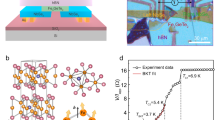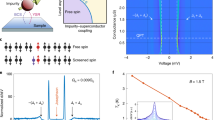Abstract
When two superconductors are electrically connected by a weak link—such as a tunnel barrier—a zero-resistance supercurrent can flow1,2. This supercurrent is carried by Cooper pairs of electrons with a combined charge of twice the elementary charge, e. The 2e charge quantum is clearly visible in the height of voltage steps in Josephson junctions under microwave irradiation, and in the magnetic flux periodicity of h/2e (where h is Planck's constant) in superconducting quantum interference devices2. Here we study supercurrents through a quantum dot created in a semiconductor nanowire by local electrostatic gating. Owing to strong Coulomb interaction, electrons only tunnel one-by-one through the discrete energy levels of the quantum dot. This nevertheless can yield a supercurrent when subsequent tunnel events are coherent3,4,5,6,7. These quantum coherent tunnelling processes can result in either a positive or a negative supercurrent, that is, in a normal or a π-junction8,9,10, respectively. We demonstrate that the supercurrent reverses sign by adding a single electron spin to the quantum dot. When excited states of the quantum dot are involved in transport, the supercurrent sign also depends on the character of the orbital wavefunctions.
This is a preview of subscription content, access via your institution
Access options
Subscribe to this journal
Receive 51 print issues and online access
$199.00 per year
only $3.90 per issue
Buy this article
- Purchase on Springer Link
- Instant access to full article PDF
Prices may be subject to local taxes which are calculated during checkout




Similar content being viewed by others
References
Josephson, B. D. Possible new effects in superconductive tunnelling. Phys. Lett. 1, 251–253 (1962)
Tinkham, M. Introduction to Superconductivity 2nd edn (McGraw-Hill, Singapore, 1996)
Bulaevskii, L. N., Kuzii, V. V. & Sobyanin, A. A. Superconducting system with weak coupling to the current in the ground state. JETP Lett. 25, 290–294 (1977)
Glazman, L. I. & Matveev, K. A. Resonant Josephson current through Kondo impurities in a tunnel barrier. JETP Lett. 49, 659–662 (1989)
Spivak, B. I. & Kivelson, S. A. Negative local superfluid densities: The difference between dirty superconductors and dirty Bose liquids. Phys. Rev. B 43, 3740–3743 (1991)
Bauernschmitt, R., Siewert, J., Nazarov, Yu. V. & Odintsov, A. A. Josephson effect in low-capacitance superconductor–normal-metal–superconductor systems. Phys. Rev. B 49, 4076–4081 (1994)
Rozhkov, A. V., Arovas, D. P. & Guinea, F. Josephson coupling through a quantum dot. Phys. Rev. B 64, 233301 (2001)
van Harlingen, D. J. Phase-sensitive tests of the symmetry of the pairing state in the high-temperature superconductors - Evidence for dx2-y2 symmetry. Rev. Mod. Phys. 67, 515–535 (1995)
Ryazanov, V. V. et al. Coupling of two superconductors through a ferromagnet: Evidence for a π-junction. Phys. Rev. Lett. 86, 2427–2430 (2001)
Baselmans, J. J. A., Morpurgo, A. F., van Wees, B. J. & Klapwijk, T. M. Reversing the direction of the supercurrent in a controllable Josephson junction. Nature 397, 43–45 (1999)
Ralph, D. C., Black, C. T. & Tinkham, M. Spectroscopic measurements of discrete electronic states in single metal particles. Phys. Rev. Lett. 74, 3241–3244 (1995)
Black, C. T., Ralph, D. C. & Tinkham, M. Spectroscopy of the superconducting gap in individual nanometer-scale aluminum particles. Phys. Rev. Lett. 76, 688–691 (1996)
Buitelaar, M. R., Nussbaumer, T. & Schönenberger, C. Quantum dot in the Kondo regime coupled to superconductors. Phys. Rev. Lett. 89, 256801 (2002)
Buitelaar, M. R. et al. Multiple Andreev reflections in a carbon nanotube quantum dot. Phys. Rev. Lett. 91, 057005 (2003)
Jarillo-Herrero, P., van Dam, J. A. & Kouwenhoven, L. P. Quantum supercurrent transistors in carbon nanotubes. Nature 439, 953–956 (2006)
Doh, Y. J. et al. Tunable supercurrent through semiconductor nanowires. Science 309, 272–275 (2005)
Wagner, R. S. & Ellis, W. C. Vapor-liquid-solid mechanism of single crystal growth. Appl. Phys. Lett. 4, 89–90 (1964)
Morales, A. M. & Lieber, C. M. A laser ablation method for the synthesis of crystalline semiconductor nanowires. Science 279, 208–211 (1998)
Björk, M. T. et al. One-dimensional heterostructures in semiconductor nanowhiskers. Appl. Phys. Lett. 80, 1058–1060 (2002)
Verheijen, M. A., Immink, G., de Smet, T., Borgström, M. T. & Bakkers, E. P. A. M. Growth kinetics of heterostructured GaP-GaAs nanowires. J. Am. Chem. Soc. 128, 1353–1359 (2006)
Sohn, L. L., Kouwenhoven, L. P. & Schön, G. (eds) Mesoscopic Electron Transport (Kluwer, Dordrecht, 1997)
Baselmans, J. J. A., Heikkilä, T. T., van Wees, B. J. & Klapwijk, T. M. Direct observation of the transition from the conventional superconducting state to the π state in a controllable Josephson junction. Phys. Rev. Lett. 89, 207002 (2002)
Averin, D. V. & Nazarov, Y. V. in Single Charge Tunneling (eds Grabert, H. & Devoret, M. H.) Proc. NATO ASI Ser. B 294 217–247 (Plenum, New York, 1991)
Björk, M. T. et al. Tunable effective g factor in InAs nanowire quantum dots. Phys. Rev. B 72, 201307 (2005)
Shimizu, Y., Horii, H., Takane, Y. & Isawa, Y. Multilevel effect on the Josephson current through a quantum dot. J. Phys. Soc. Jpn 67, 1525–1528 (1998)
Goldhaber-Gordon, D. et al. Kondo effect in a single-electron transistor. Nature 391, 156–159 (1998)
Cronenwett, S. M., Oosterkamp, T. H. & Kouwenhoven, L. P. A tunable Kondo effect in quantum dots. Science 281, 540–544 (1998)
Choi, M. S., Lee, M., Kang, K. & Belzig, W. Kondo effect and Josephson current through a quantum dot between two superconductors. Phys. Rev. B 70, 020502 (2004)
Siano, F. & Egger, R. Josephson current through a nanoscale magnetic quantum dot. Phys. Rev. Lett. 93, 047002 (2004)
Acknowledgements
We thank Y.-J. Doh and L. Glazman for discussions, G. Immink for nanowire growth, and A. van der Enden and R. Schouten for technical support. Financial support was obtained from the Dutch Foundation for Fundamental Research on Matter (FOM), the Dutch Organisation for Scientific Research (NWO), the EU programmes HYSWITCH and NODE, and the Japanese International Cooperative Research Project (ICORP). Author Contributions J.A.v.D., S.D.F. and L.P.K. are responsible for quantum transport experiments, Y.V.N. for numerical simulations, and E.P.A.M.B. for nanowire growth.
Author information
Authors and Affiliations
Corresponding author
Ethics declarations
Competing interests
Reprints and permissions information is available at npg.nature.com/reprintsandpermissions. The authors declare no competing financial interests.
Supplementary information
Supplementary Notes
This file contains Supplementary Methods (nanowire growth and device fabrication), Supplementary Data (data for a seconds device), Supplementary Discussion (supercurrent reversal) and Supplementary Methods (numerical evaluation of supercurrents). (DOC 122 kb)
Supplementary Figure 1
Scanning Electron Microscopy images. (PDF 758 kb)
Supplementary Figure 2
Supercurrent reversal in the second device. (PDF 102 kb)
Supplementary Figure 3
Energy diagrams illustrating transport through a multi-level quantum dot. (PDF 85 kb)
Rights and permissions
About this article
Cite this article
van Dam, J., Nazarov, Y., Bakkers, E. et al. Supercurrent reversal in quantum dots. Nature 442, 667–670 (2006). https://doi.org/10.1038/nature05018
Received:
Accepted:
Issue Date:
DOI: https://doi.org/10.1038/nature05018
This article is cited by
-
Phase and Thermal-Driven Transport Across T-Shaped Double Quantum Dot Josephson Junction
Journal of Superconductivity and Novel Magnetism (2023)
-
Superconducting quantum interference at the atomic scale
Nature Physics (2022)
-
Andreev Bound States in Superconductor–quantum Dot–superconductor Junction At Infinite-U Limit
Journal of Superconductivity and Novel Magnetism (2022)
-
Van der Waals ferromagnetic Josephson junctions
Nature Communications (2021)
-
Giant fractional Shapiro steps in anisotropic Josephson junction arrays
Communications Physics (2020)
Comments
By submitting a comment you agree to abide by our Terms and Community Guidelines. If you find something abusive or that does not comply with our terms or guidelines please flag it as inappropriate.



